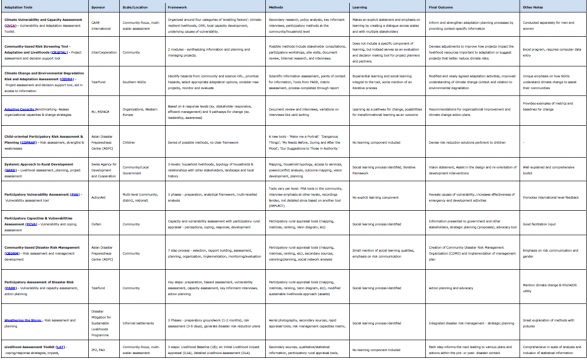Participatory tools to aid vunerability assessment and adaptation

The table below is a summary by Kathleen Dietrich of Penn State University of the some of the many different tools used by practitioners in their work on adaptation. Many of these tools started life in the Development or Disaster Risk reduction fields, but have been being applied to support adaptation also.

(Please click to enlarge, or alternatively there is a download link at the bottom of the page)
New Content
Participatory Toolkit for Impacts and Adaptation
- DFID/UKAID’s Livelihoods and Forestry Programme in Nepal has just published a step-by-step guide to assessing the impact of climate change on forest dependent communities. This tool kit is designed to help communities and planners understand the likely local hazards and risks of climate change and look at the vulnerability of their environment and livelihoods. It helps them to analyse exiting methods of coping and adapting and then develop plans to increase resilience. The kit consists of a range of tools that can be used in various situations. District or VDC (Village Development Committee) level planning teams can use them to make assessments and gain an overview. Community based organisations (such as forest user groups, water management groups or soil conservation groups) can use them to prepare themselves and develop community level adaptation plans. Further information is available here and you can download the kit here.
Suggestions and feedback
How easy was it? Did it do what you expected? Did it help you to make a decision about adaptation in your project? Is there anything else that you wish it could do?
If we can start answering these questions then I think we can really build a resource that other users will find useful, and also that the developers of the tools themselves will find useful!
Please feel free to email us with suggestions of new content for this list or general feedback on this page.
(0) Comments
There is no content